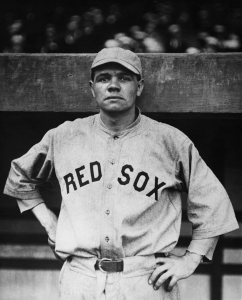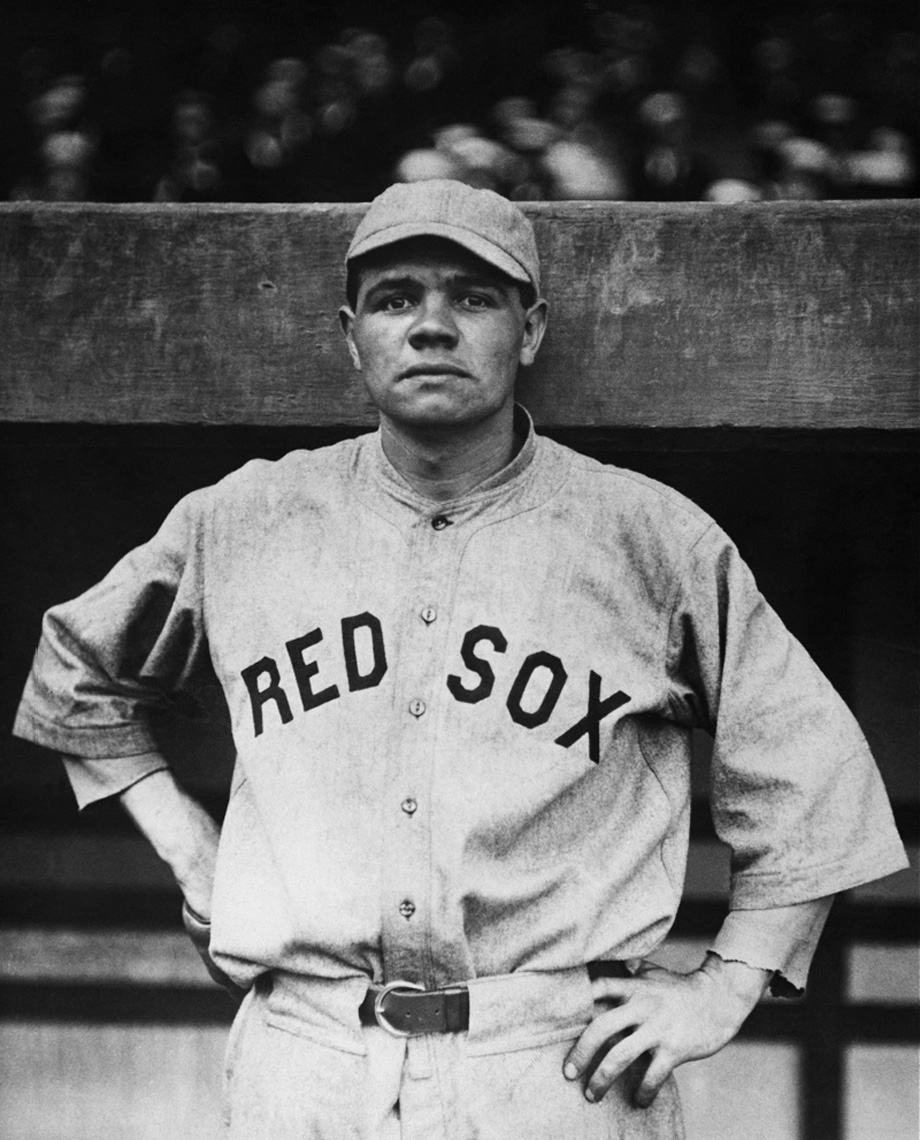April 18, 1919: Babe Ruth thrills hometown Baltimore fans with 6 home runs in 6 at-bats

Babe Ruth put on a home-run show in his hometown on April 18, 1919. The Boston Red Sox pitcher-outfielder swatted four round-trippers in four at-bats during a chilly, one-sided exhibition game against the Baltimore Orioles.
The Babe had begun to make his grand transition from top-flight left-handed pitcher to full-time outfielder and slugger. In 1918 he tied Philadelphia Athletics outfielder Tillie Walker for the major-league lead in homers with 11. (Ruth went to bat almost 100 fewer times than Walker.)
It was a hectic time in the baseball world. Because of US involvement in World War I, teams played abbreviated schedules in 1918. The Red Sox defeated the Chicago Cubs in the World Series, which was held in early September. When the war ended two months later, players who were in the military or had taken stateside jobs to support the war effort flocked back to their teams.
Red Sox owner Harry Frazee made several offseason moves while handling contract negotiations with many of his star players who were holding out for more money. Those holdouts included Ruth, who, in addition to his work with the bat, went 13-7 with a 2.22 ERA on the mound in 1918.
On March 18, 1919, Red Sox manager Ed Barrow and 10 of his players boarded the steamer Arapahoe in New York Harbor. When the ship docked at Jacksonville, Florida, Barrow and his party traveled by rail to Tampa for the start of spring training. Another contingent of Red Sox skipped the scenic trip down the Eastern Seaboard and took the train directly to Tampa.
The remaining unsigned men – including the Babe – stayed at home, while shortstop Everett Scott reported to camp without a contract.
On March 22 Frazee and Ruth finally came to an agreement. The national newspapers reported that the Bambino had inked a three-year deal worth $27,000. The other Red Sox holdouts soon followed suit, Scott being the last to sign.
After a few weeks in Florida, including a game in which Ruth blasted what is believed to be the longest home run ever hit in Tampa, the Red Sox headed northward.1 One scheduled stop was at Richmond, where the Red Sox and Baltimore Orioles were slated to play a three-game series at Boulevard Park. From there, both clubs would travel to Baltimore for two more games at Oriole Park. The Richmond promoters belatedly called off the games with Baltimore, choosing instead to showcase local ballclubs against the reigning World Series champs.
When the games in Richmond were canceled, Orioles owner-manager Jack Dunn contacted Harry Frazee about scheduling a third game in Baltimore. Dunn had purchased the Baltimore franchise from owner Ned Hanlon in 1909 for a reported $35,000. Dunn signed George Herman Ruth, a standout pitcher for St. Mary’s Industrial School, to his first professional contract in February of 1914. Later that season, Dunn’s team began losing money because of stiff competition at the box office from Baltimore’s Federal League franchise. To remain fiscally solvent, Dunn began selling off his star players. He sent Ruth to the Red Sox, along with Ben Egan and Ernie Shore.
Frazee and Dunn agreed to play an additional game in Baltimore on April 17, the day before the series was originally scheduled to start. But Frazee didn’t inform anyone from the Boston organization about the change in plans. That afternoon a few hundred people, braving the unseasonably cold weather, showed up at Oriole Park. Regrettably for these diehard fans, the Boston club was not at the ballpark or even in Baltimore for that matter. Regarding the mixup, the Baltimore Sun wrote, “It is believed that Frazee forgot to notify Barrow of the change regarding yesterday which caused the manager to remain in Richmond instead of coming to this city yesterday morning.”2
The Red Sox left Richmond by train on the evening of April 17, arriving at the railway station in Baltimore at 1:30 the next morning. Later that afternoon, Boston and Baltimore took the field at Oriole Park in front of 2,000 wind-chilled fans.
Dunn gave the starting assignment to Allen “Lefty” Herbert, while Barrow went with southpaw Herb Pennock.3
Veteran infielder Jack Barry started off the Boston offense by doubling in the opening inning. Amos Strunk followed with a single, Barry holding at third. Walks to Ruth and Ossie Vitt pushed across a run before Herbert worked his way out of trouble. The Orioles countered with a run in the bottom of the first. Merwin Jacobson lashed an opposite-field single, then advanced to third on a wild pitch and passed ball. Jacobson came home on Johnny Honig’s base hit up the middle.
Neither club scored in the second. In the third, Ruth’s two-run homer, along with Everett Scott‘s sacrifice fly, bumped up the score to 4-1. Left-hander Sam Hersperger replaced Herbert on the mound during this inning.
Baltimore scored two runs in the bottom of the third. Fritz Maisel led off with a single to center. After a passed ball allowed Maisel to advance to second, Jacobson reached first base on an error by Scott at short. Max Bishop followed with a walk to load the bases. After Honig struck out, Joe Boley swatted a single to right that plated two runs.
Hersperger, who once struck out 21 batters in a game against the Gallaudet College Reserves, began having control issues in the fourth. Dunn replaced him with Harry Frank. In his first at-bat against the new pitcher, Ruth smacked a towering blast over the fence in right-center field. The Baltimore Sun observed, “This was the real drive of the day. It went between two houses fronting on Greenmount Avenue and the rest of its travels were not reported at a late hour last night.”4 When the dust cleared, the Red Sox had padded their lead to the tune of 7-3.
Sam Jones relieved Pennock in the sixth and held the Orioles scoreless for the remainder of the contest. Frank, meanwhile, finished out the game for Baltimore and allowed five more Red Sox runs. Ruth remained locked in, cranking a solo home run over the right-field wall in the seventh and another in the ninth. When the last out was recorded, the scoreboard read Boston 12, Baltimore 3.
Ruth, who patrolled left field and batted fifth, went 4-for-4 with four homers and two walks. In regard to Ruth’s power display, the Baltimore Sun wrote, “Yes, Johnny Honig and Merwin Jacobson practically sat on the wall surrounding Oriole Park yesterday, but four times Babe Ruth, the greatest clouter baseball ever has known, drove the white rocket far over their heads thus equaling the batting record established years ago by big Ed Delahanty.”5
Center fielder Strunk contributed four hits for Boston. Honig, Jacobson, and Sumpter Clarke collected two hits each for Baltimore. The following afternoon, the two teams squared off again at Oriole Park on another raw day in front of 3,000 hardy souls. Ruth pitched the first four innings, at one point retiring 10 consecutive batters before giving up a run. In keeping with his hot hitting from the previous day, the Babe belted homers in his first two plate appearances.
Former Philadelphia Athletics right-hander Rube Parnham was Ruth’s first victim. Babe launched one of Parnham’s offerings high over a candy advertisement sign on the right-field fence. Reporters covering the game noted that Ruth hit a pitch that was at least three inches outside. New York native Bert Lewis relieved Parnham in the fourth and lasted only a third of an inning before being replaced by left-hander Rudy Kneisch.
The Bambino’s second blast of the day came off Kneisch, the ball soaring high over the wall in right field. Kneisch gained some redemption by fanning Ruth in the slugger’s third and final at-bat of the game. Veteran submarine pitcher Carl Mays took over for Ruth in the fifth, allowing one run over the next five frames. The lopsided affair ended with Boston up 16-2. The following day, the Baltimore Sun noted that Ruth had compiled 18 round-trippers since the start of the spring exhibition games.
When asked by a reporter about hitting six home runs in front of his hometown fans, the Babe replied, “I was afraid some of my old neighbors didn’t believe all that they’ve read in the papers about me. This was my chance to show them what I could do.”6
Ruth’s heavy hitting would carry over into the regular season. The future Sultan of Swat ushered in the live ball era with a major-league leading 29 home runs. The Babe’s new mark eclipsed the old record of 27 set by the Chicago White Stockings’ Ed Williamson in 1884.
Sources
In addition to the sources cited in the Notes, the author consulted Baseball-reference.com and the Baltimore American, Harrisburg Telegraph, New York Sun, New York Tribune, Richmond Times-Dispatch, Washington Herald, and Washington Post.
Keenan, Jimmy. “Jack Dunn,” SABR BioProject, at https://sabr.org/bioproj/person/e1addacb.
Lowry, Philip. Green Cathedrals (New York: Walker Publishing, 2006).
Montville, Leigh. The Big Bam: The Life and Times of Babe Ruth (New York: Doubleday Publishing, 2006).
Russo, Frank. The Cooperstown Chronicles: Baseball’s Colorful Characters, Unusual Lives, and Strange Demises (Lanham, Maryland: Rowman and Littlefield Publishers, 2014), 98-99.
Steinberg, Steve, and Lyle Spatz. The Colonel and The Hug: The Partnership that Changed the New York Yankees (Lincoln: University of Nebraska Press, 2015).
Thanks to the Enoch Pratt Library of Baltimore.
Notes
1 On the home run in Tampa, see roadsideamerica.com/story/14158.
2 “To Open Series Today,” Baltimore Sun, April 18, 1919: 9.
3 Herbert had been a standout at Mount St. Joseph High School in Baltimore and St. John’s College in Annapolis before signing with the Orioles. Pennock had started his big-league career with the Philadelphia Athletics in 1912 and was acquired on waivers by Boston in 1915. Pennock rejoined the Red Sox in March of 1919 after his discharge from the Navy.
4 C. Starr Mathews, “Equals World’s Record,” Baltimore Sun, April 19, 1919: 10.
5 Ibid.
6 Allan Wood, Babe Ruth and the 1918 Red Sox (Bloomington, Indiana: iUniverse publishing, 2000), 349.
Additional Stats
Boston Red Sox 12
Baltimore Orioles 3
Oriole Park
Baltimore, MD
Corrections? Additions?
If you can help us improve this game story, contact us.


